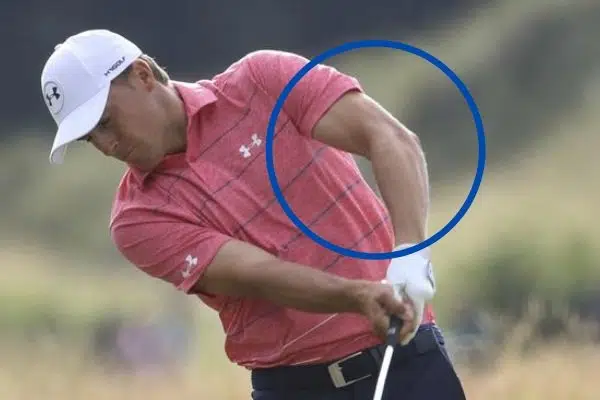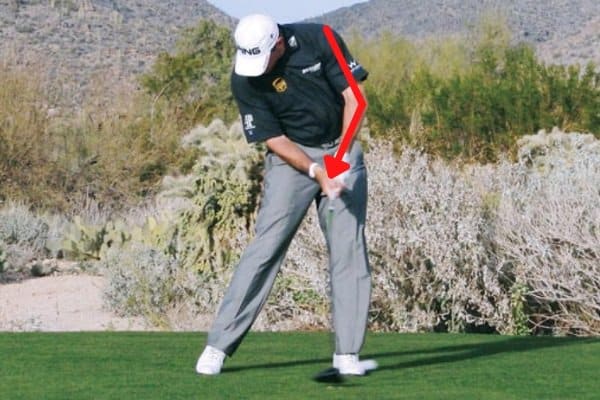The chicken wing is a distance and accuracy killing flaw in the golf swing of many amateurs, caused by a range of different factors.
Rather than rotating their straight lead arm through the ball and maintaining its connection to the body through impact, those with this flaw make a flexing action, bending at the elbow and allowing the arm to flare out and lift upwards.
It often comes about due to a poor concept of how the body works in the golf swing in order to release the ball on line towards the target.
People with a lack of rotation and a tendency to want to ‘guide’ the ball towards their target may feel as if a lifting, chicken wing movement is the only real way to get the ball launching in the intended direction.
Unless addressed, the chicken wing will only hurt the distance you get and your consistency of strike.
In this article, I’ll explain in greater depth what causes a chicken wing in your golf swing, and how you can remedy it.
Table of contents
What is a chicken wing in golf?
The chicken wing is a movement in the follow through where the lead arm detaches from the body and starts to bend, like the wing of a chicken. The elbow lifts upwards and flares out from the body, often causing poor strikes, loss of distance and shots missing to the right.
It’s a move that’s practically absent on the pro tour, with the exception of someone like Lee Westwood (pictured in the above image) or Jordan Spieth, as it is an inefficient way to make a good connection with the ball.
It is important to note, when considering Lee Westwood, that he is a pro with better hand eye coordination than the casual weekend player; his chicken wing is only slight; and he still makes a good rotation.
For the average Joe golfer, the chicken wing is less likely to be a minor quirk of a unique swing, more so a symptom of underlying, problematic flaws.
Essentially, instead of the lead arm (left arm for a right-handed golfer) staying relatively straight and connected to the left side of the body before rotating through impact, the left elbow cocks and raises upwards.
What causes a chicken wing in the golf swing?
One of the main causes of a chicken wing in the golf swing is a grip that is too strong, so adjusting this first and foremost could offer a solution. It may also be caused by a lack of rotation in the body, or a belief that the club needs to swing on a ‘back and through’ plane to go straight, rather than around the body.
A flaw quite often seen in older golfers, largely as a result of inflexibility or a loss of strength, is a swing that goes back and through, rather than rotating in an arc around the body.
In newer golfers, a similar flaw may present, but less so due to physical limitations and more so a lack of concept about how the golf swing actually takes place, rotating on a path around the body.

By failing to rotate, the lead arm won’t find a natural course where it rolls through to the left after impact, so folding it upwards is the only way to really clear it as you make contact with the ball.
The Swing Align Golf Training Aid bundle is a useful set of tools that will help you fine-tune the perfect rotation to avoid a chicken wing.
This bundle has several alignment sticks that will help you sync the arms and shoulders with your target line before beginning the downswing, gradually forming the habit of making a full rotation.
Are chicken wings bad in the golf swing?
Developing a chicken wing in the golf swing is bad as it will hurt distance and consistency, as well as cause shots that predominantly miss to the right. The chicken wing can also be an indicator of fundamental flaws and underlying issues in your swing, so it is important to try and understand why you have developed this problem and how to fix the cause.
There are many reasons why people might swing with a chicken wing including grip, rotation and general misconceptions of how to swing the golf club.
By performing some drills or using some products (discussed below) designed to fix the underlying problems that lead to the chicken wing, it is definitely something you can remedy in order to improve your golf swing.
Does a chicken wing cause a slice in golf?
The chicken wing in golf often causes a slice or shots that miss to the right. As golfers with this flaw fail to rotate their arms and hips through impact, it can result in over-the-top strikes or ‘holding the club off’, both mistakes synonymous with misses to the right.
These actions can come about largely due to misconceptions about how to swing the golf club.
Fear of going left often means our brain will do everything in its power to make us avoid rotating around to the left through impact, which is kind of silly given it just leads to the opposite problem: shots missed out right.
One of the biggest reasons why people develop a chicken wing is that they don’t rotate the shoulders and hips around and to the left through impact, meaning that the arms and club don’t really have anywhere to go, so they fold up into a chicken wing.
All this leads to is a club path that comes over-the-top or a face that doesn’t adequately close through impact.
To work on hip rotation – which will allow the arms to rotate and promote a draw, rather than a slice – place an alignment stick through your belt buckle so that it points towards your target at address.
If this alignment stick points straight towards your target through impact, rather than off to the left of your target, then the hips aren’t opening enough, stopping you from being able to release the club and rotate the arms.
If you master this movement rather than performing a chicken wing, you’ll actually have the space to roll the arms through properly and complete a full release.
How do you get rid of a chicken wing in the golf swing?
To get rid of the chicken swing you need to stop the lead arm disconnecting from the body and bending through impact. However, if you do this without addressing underlying issues like a closed clubface, you might find it causes you to hook the ball. It is vital to determine what has led to the chicken wing and correct this prior to remedying the chicken wing itself.
Then, you can start working on rotating the body better throughout your swing.
The video below from YouTube experts Me and My Golf outlines a simple drill to keep that connection between the lead arm and the body through impact.
All you need is a headcover or similar object tucked under your left armpit.
Start off by making a few half swings, as for someone who has developed a chicken wing over time, this will feel like quite a foreign movement.
Gradually build up to fuller swings, focusing on the headcover staying between the arm and body without falling to the ground as you swing.
In order to make this happen, your lead arm will be forced to roll and rotate through the shot, rather than flare up and out, creating the muscle memory to eradicate this flaw.
While a headcover will do the job, albeit in a very basic fashion, there are far better products out there on the market, specifically designed to keep the arms and body connected and to avoid a chicken wing in the golf swing.
The LC-1 Golf Swing Training Aid connects the arms and body to groove the ultimate, efficient swing.
It is fully adjustable, so can be set to the optimum width between the arms for any golfer.
By forcing the arms to keep connected, this training aid will ensure you swing in a more in-to-out path, forming a swing with a nice draw shape – something those with a chicken wing struggle to perform.
A cheaper option is the Golf Smart Inflatable Ball Set which follows a similar yet slightly different methodology to the headcover drill.
This ball is tucked between the forearms when completing the golf swing, with the aim being to ensure the ball does not drop out from the arms.
Like with the headcover drill, this forced connection between the arms means you’ll need to roll, rather than bend and lift that lead arm to complete a swing with the ball intact.
Final message
The chicken wing is a frustrating issue for many as it can be so damaging for distance as well as cause an unenviable slice.
In order to fix it, really focus on two things: hip/shoulder rotation and maintaining connection between the lead arm and the body.
Work on these elements of the swing and if you can kiss that chicken wing goodbye, there’s every chance that the resulting high draw will give you greater distance that is the envy of your playing partners.
- TaylorMade SIM2 Max Driver vs M4 Driver: Worth it in 2024? - April 15, 2024
- 3 Ways to Win the Mental Game with the Bridgestone Mindset Golf Ball - March 29, 2024
- TaylorMade SIM Max & SIM2 Max Drivers: Are they Still Relevant in 2024? - March 9, 2024


